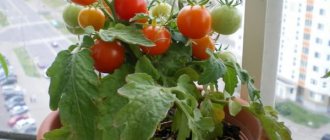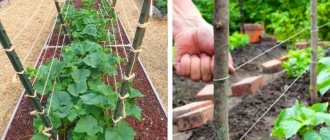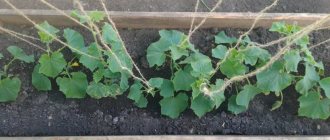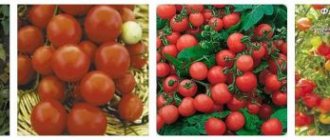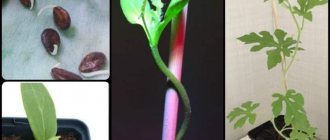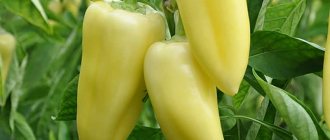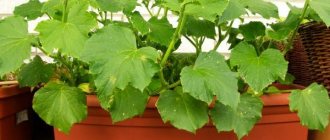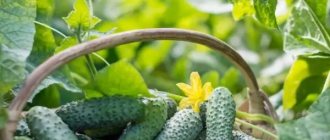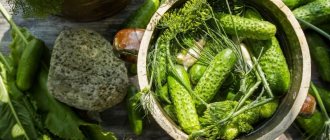Which balcony is suitable for growing cultivated plants?
The best option for growing cucumbers and other vegetables is a south-facing balcony. Under such conditions, you can grow vegetables for six months. If the balcony faces north, you cannot do without a greenhouse or greenhouse. The northern balcony must be insulated.
Vegetables require special conditions to develop and bear fruit. The main factors for the growth of cucumbers are light and heat. The lack of both has an adverse effect on the harvest; moreover, there may be no fruit on the plants at all.
The southern balcony is more suitable for growing vegetables, but access to the south side is not a prerequisite - favorable conditions can be created under any circumstances.
Variety "City cucumber"
Photo: City cucumber
Hybrid, which is cultivated on a loggia or in an apartment.
Peculiarities:
- bunched gherkin;
- internodes are short;
- small sheets;
- increased shade tolerance;
- begins to bear fruit at 39-41 days;
- develops 4-10 ovaries;
- fruits are 10-13 cm long, weighing 70-95 grams.
Cucumber is very tasty fresh. Zelentsy are well suited for canning. Vegetables can be grown in an open garden bed or under a film cover. Viable and unpretentious.
Conditions for growing cucumbers on the balcony
The biggest challenges when growing on a balcony are temperature and light. Cucumbers require a lot of light and heat to grow and bear fruit.
Lighting
An important condition for the growth of cucumbers is good lighting. In summer, enough light penetrates onto balconies and loggias through double-glazed windows. The problem may appear in March when there is not enough natural light for vegetables to grow. To eliminate the shortage of light, special lamps for greenhouses are placed on the balcony - they are left on all night.
Temperature
The ideal temperature for the growth of cucumbers is 18-22°C. To ensure such a temperature on the balcony, conventional glazing is not enough. Cucumbers are sown in February, when it is still very cold outside. In order for the temperature on the balcony to be at room temperature, it must be additionally insulated.
At temperatures above +22°C, plants wither and the soil dries out - it has to be moistened more often than required, which contributes to the development of fungal diseases. If the thermometer drops below +18°C, although the bushes will grow, they will not produce ovaries.
Variety "Swallowtail"
Photo: variety “Swallowtail”
A distinctive property of the variety is that the fruits ripen early. Hybrid with female flowers, fascicle, gherkin, parthenocarpic. It has shortened internodes. The shoots on the sides are dense, but short. From 2 to 11 pieces of future fruits are tied in knots.
Greens are spindle-shaped. Their length is up to 12 cm, weight – 60-110 grams.
The taste of cucumbers is excellent. They are juicy, fragrant, filling. Taste qualities are preserved during salting and pickling.
The variety is unpretentious, resistant to cucumber diseases.
Cucumbers are great for growing on balconies and window sills. They can be grown in open beds and under film.
Preparing for landing
In order for cucumbers to be not just balcony plants, but a truly productive vegetable, it is necessary to properly prepare the planting site and cucumber “beds”.
Preparing containers and place
In order for cucumbers to grow on the balcony without problems, it is necessary to think through the control system to the smallest detail - at the slightest frost, cucumbers die. Depending on the growing period, provision of optimal temperature and lighting is provided.
The role of “beds” will be played by various containers. Features of container selection:
- To obtain seedlings, you need small containers, for example, disposable plastic cups. Even better are peat glasses. But not for early ripening varieties - their root system grows faster than the peat container dissolves.
- Large boxes are suitable for planting seedlings. Cucumbers can also be grown in pots, trays, and buckets. Cucumber roots love space, so adult plants are grown in 5-10 liter containers. If boxes are used, then plastic or wooden ones can only serve as flowerpots.
- Any container for growing cucumbers must have holes for excess water to drain out. To prevent water from spilling over the balcony, containers with seedlings and adult plants are placed on trays or pallets.
Seedlings grown in peat cups are transplanted into the soil along with the container - it will not only dissolve over time, but will also fertilize the soil.
Bags are also suitable as containers. One bag holds 2-3 bushes (3 plants per 1 sq. m).
Planting soil
Cucumbers need loose and fertile, well-fertilized soil. You can buy universal soil - “for seedlings”. Dry peat lands must be enriched by adding black soil, humus and sawdust. Looseness is added to the soil using river sand, perlite or vermiculite.
You can prepare the soil for cucumbers yourself by taking in equal proportions
- humus;
- peat;
- sawdust;
- turf.
On a bucket of the mixture prepared according to this recipe, put urea - one teaspoon, and nitrophoska - one tablespoon. It is recommended to add ash and complex fertilizer to the soil mixture - 50 g each.
Seeds
Sowing seeds for seedlings begins in March or even February. The time for planting sprouts in the ground is April. Many balcony varieties are early ripening; on average, 2-2.5 months pass from sowing to fruit ripening.
Seed preparation:
- The seeds are soaked in a weak solution of potassium permanganate (potassium permanganate).
- After 20 minutes, the seeds are removed from the potassium permanganate and laid out on damp gauze placed in a deep bowl. The gauze is moistened with water heated to 60°C.
- The seeds are germinated for 2-3 days, periodically moistening the gauze.
- When the seeds “hatch”, they are carefully planted in glasses so as not to damage the sprouts. One seedling is grown in one glass. Planting depth – 1.5-2 cm.
To get good seedlings, the seeds must be germinated. They keep the crops in the room - they will be cold on the glassed-in balcony.
Variety "Balcony miracle"
Photo: Balcony miracle variety
One of the species bred by breeders to be grown in a room on a window sill or on a balcony. A plant with a dense, compressed root system that does not require much soil. The variety is high-yielding, the fruits have a special taste. The pulp of the greens is juicy, sweetish, without the presence of bitterness.
The cucumber tolerates partial shade and does not require additional lighting. The flowers are self-pollinating, female type of flowering, high yields are guaranteed. Cucumbers do not require special care; they are unpretentious, viable, and not susceptible to disease.
The vines of the plant are not very long, no more than 2 meters. The internodes are shortened, but there are many of them. Each one develops 3-5 ovaries.
Gherkins are neat, up to 10 cm long, weighing up to 110 grams. The shape of Zelentsy is a cylinder. There are small tubercles on the skin. Cucumbers are very tasty fresh. They are salted and pickled. Even from jars, cucumbers remain appetizing and fragrant.
“Balcony Miracle” cucumbers are suitable not only for balconies and window sills. They are grown in beds in open ground and in greenhouses. The harvest may exceed the number of cucumbers grown on the balcony.
Caring for young seedlings
Young seedlings are helpless in the face of cold. The main thing is to provide them with optimal temperature conditions. Crops can be placed on the windowsill 3-4 days after planting the seeds in the ground. When the room is ventilated, the glasses with the crops are taken to another place, or covered with something.
Light
If the room in which seedlings are grown lacks light, turn on artificial lighting. Illumination lamps are positioned so that the seedlings are at a sufficient distance from the light sources.
The seedlings should not be exposed to direct sunlight.
Watering and fertilizing
Watering rules:
- The seedlings are watered daily.
- For irrigation use water +27°C - this is room temperature. It must be settled.
- If artificial lighting is used, the frequency of watering can be doubled.
- If a lot of water flows out through the drainage holes, reduce the rate or frequency of watering.
To ensure that the seedlings are strong and ready for transplanting to the balcony, they are grown in a room for about a month. During this time, it is recommended to feed the plant three times.
Composition of fertilizers for seedlings:
| When to fertilize | Compound |
| 10 days after sowing | Urea solution. For 3 liters of water – 1 tbsp. l. Half a glass of solution per plant. |
| 10 days after the first feeding | Dissolve in 8 liters of water:
|
| 10 days after the second feeding | Any of the two compositions above. |
April cucumber
Cucumber "April"
A hybrid of the female flowering type, self-pollinating, suitable for growing on a windowsill and balcony. The fruits begin to ripen 40-45 days after planting the seeds. Distinctive features of this variety.
- The plant is low, bushy, no higher than 30 cm.
- Vegetables are cylindrical in shape. The skin has large white tubercles and spines.
- The weight of the fetus does not exceed 220-250 grams.
- The pulp of greens is plump, appetizing, without bitterness.
- If the fruits are not collected on time, they will turn yellow and overgrow.
- The variety is resistant to diseases.
- With good, regular care of the plant, the yield increases to 15 kg per 1 square meter.
When cultivated in the garden, the yield increases by 35-45%.
Transplanting seedlings
Seedlings are planted in containers 30 days after sowing. The last feeding should be done at least 7 days before transplanting.
Procedure for planting cucumber seedlings:
- One hour before transplanting, the seedlings are watered with heated water.
- One plant at a time is planted in one container - a pot or bucket. The approximate dimensions of the container are from 30x30x30 cm. Each container must have drainage and drainage. The role of the latter is played by pallets on which the pots are placed.
- Make a hole in the center of the container with soil.
- Water the hole with warm water.
- Move the roots of the seedling into the hole along with a lump of soil.
- Sprinkle with soil and gently compact it.
- Water again.
In order for the seedlings to take root and take root better, it is recommended to replant them in soil similar in composition to the one in which the seedlings were grown.
Containers with planted seedlings are placed so that they are not exposed to the open sun. They are also contraindicated in drafts. It is best to place boxes and pots near the side walls of the balcony and in its corners. Immediately after arranging the containers, you can install devices for the lashes - a trellis or a net.
Garland
variety "Garland"
Hybrid. Amazing variety. When they ripen, there are so many greens that the plant resembles a Christmas tree with garlands. The variety amazes with rich harvests.
Shade-tolerant bush. The flowers are female and self-pollinating. The fruits are medium-sized from 13-17 cm, weighing up to 125 grams.
Cucumbers have excellent taste. Vegetables are suitable for fresh consumption. Salted and pickled cucumbers are also good.
There are a lot of cucumber varieties bred by breeders for balconies and apartments.
Note! Seeds of green hybrids do not germinate. Planting material will have to be purchased from the store annually.
Caring for cucumbers on the balcony
In order for plants to grow and bear fruit well, it is necessary to provide them with optimal conditions. Cucumbers need watering, fertilizing, and loosening the soil.
Irrigation scheme
Features of watering cucumbers on the balcony:
- For irrigation, use settled, non-cold water.
- Water the cucumbers every day. We must ensure that the soil does not dry out.
- If water stagnates in the trays, the rate or frequency of watering must be reduced.
- Do not over-moisten the soil - the roots may begin to rot.
It is important to moisten not only the soil, but also the air - if low humidity is observed. To do this, install a humidifier or spray the space with a regular spray bottle. You can also increase the humidity by installing containers with water.
When irrigating air from a spray bottle, do not allow water to get on the plants.
After moisture is absorbed, the soil is carefully loosened. If the soil in pots and containers settles, you need to fill it up to the original level.
Fertilizers for cucumbers
There is an opinion that due to an excess of fertilizers, cucumbers bear fruit poorly. But if fertilizing is applied on time and in the right quantities, it will only bring benefits. Fertilizers are applied so that they do not fall on the leaves.
The first 3 feedings are carried out before the seedlings are planted, then the plantings are fed every 10 days. To get a lot of fruits, it is recommended to diversify your diet.
If the plants begin to dry out, they lack nutrients. During the first 2 weeks after planting, the plants are given nitrogen fertilizers; after the first vines appear, the bushes are fed with potassium.
There are many special fertilizers, but you can also use improvised means. Inexpensive but effective fertilizers for cucumbers:
- Infusion of wood ash. This fertilizing will provide the plants with potassium and phosphorus - they are needed during flowering. Leaves and soil are treated. For 2 liters of water – 1 tbsp. l. ash. Take boiled water. Before use, the infusion must be strained.
- Eggshell. This is a source of microelements - they are needed throughout the growing season. The infusion smells unpleasant - this must be taken into account when using. For 3 liters of water - the shells of four eggs. The jar is kept in the dark with the lid slightly open. When the infusion becomes cloudy and acquires a specific smell, it is ready for use.
- Banana peel. Dried and crushed peels are added to the soil - this is a good source of potassium.
- Onion peel. The infusion is used during flowering. For 5 liters of water – 20 g of onion peels. Insist for 4 days. Strain before use.
Wood ash infusion
Crushed eggshells
Banana peel as fertilizer
Fertilizer from onion peel infusion for flowering cucumbers
Foliar feeding:
- During flowering and fruit set. Plants are sprayed with a solution of boric acid (1%). Treatment is carried out repeatedly, with an interval of 10 days.
- After intensive fruit set, a solution of potassium permanganate is used. This processing makes the fruit tastier. The solution is prepared at the rate of 10 crystals per 1 liter of water. An alternative could be spraying with a urea solution - 5 g per 3 liters.
Root feeding schedule:
| Period | Feeding composition | Consumption per plant |
| Beginning of the fruit formation phase | infusion of ash (per 10 liters of water - 1 liter of ash) | 1 glass |
| During the growing season at intervals of 10 days | ROST-potassium concentrate NPK (for 3 liters of water – 6 ml of the drug) | according to the manufacturer’s recommendations – 20 g |
Forming a cucumber lash
In order for the plant to bear fruit well and not waste energy on the formation of excess green mass, it is pinched. Pinching is done taking into account the characteristics of the variety.
How to pinch cucumbers depending on the variety:
- Self-pollinating. Pinch off the first 2 or 3 ovaries. Next, you can remove the side lashes above the 3rd or 4th fruit. Self-pollinating varieties are easier to care for - they don’t even always need pinching.
- Pollinated by insects. In these varieties, the fruits are set mainly on the side shoots. Therefore, the main stem is pinched here - when the third true leaf appears, it is torn off, capturing the growth point.
Pollination
To avoid fussing with pollination, choose self-pollinating varieties. Or parthenocarpic varieties - they do not need pollination at all. All other varieties must be pollinated. In the open ground, bees do this job. On the balcony you will have to pollinate the flowers yourself.
The first step is to learn to distinguish flowers. In female flowers, the ovary is similar to a micro cucumber. They have a large corolla, painted in bright colors.
Pollination order:
- Pick a male flower. It should be fresh, fully opened.
- Tear off all the petals from the male flower.
- Move the stamens along the female flower - along the stigma of its pistil.
Flowers need to be pollinated in the morning. There must be a sufficient amount of pollen. If there is not enough of it, you cannot count on a large fruit. If pollination is successful, fruits will form in 10-12 days. Ovaries that have not been pollinated turn yellow and fall off.
Male flowers are open for one day, female flowers for 4 days.
Review of the best self-pollinating varieties and hybrids of cucumbers for the balcony
Specially bred balcony varieties and some hybrids intended for greenhouses are suitable for growing on a windowsill. Let's look at the most popular and well-proven ones.
Hummingbird
This is a gherkin-type hybrid that does not require pollinators. The leaves of the plant are small, the side shoots are short, the internodes are short, and from 3 to 10 ovaries are formed in them. The crop is high-yielding, cucumbers grow tuberculate and white-thorned, spindle-shaped, 5-8 cm long and weighing up to 80 g.
The hybrid has an interesting watermelon color. The first fruits appear already 40 days after planting the seeds. Hummingbird is completely unpretentious in cultivation and tolerates darkening well.
Another advantage is high resistance to many diseases. No pest damage is observed.
Hummingbird is good for canning.
Super bunch cucumber Hummingbird
City pickle
If there is very little growing space, the City Cucumber is an ideal option. A very hardy and unpretentious hybrid. Gherkins grow in clusters, with 4 to 10 ovaries in nodes. Fruit length is 10-12 cm, weight is up to 95 g.
The cucumber is early ripening - the fruits ripen already on the 40th day after planting - and very fruitful - they harvest from the bush for a long time.
The urban cucumber is highly resistant to many cucumber diseases. Very tasty, suitable for salads and canning.
Debut
Self-pollinating hybrid, early ripening and high-yielding. Lumpy, cylindrical greens grow up to 12-14 cm in length and weigh up to 100 g. The first cucumbers ripen 45 days after the bushes appear.
The plant is low, with a bunched ovary. It does not require special care and has good disease resistance. Debut is not suitable for canning, but fresh it has excellent taste.
April
Self-pollinating early-ripening hybrid - the fruits begin to ripen on the 45th day of planting the seeds . The plant is low, bushy. The vegetables have large tubercles and white spines, the weight reaches 200-250 g. With good care, up to 15 kg of crop can be harvested from 1 m².
There are also disadvantages: the hybrid is not suitable for winter canning and is not very resistant to cucumber diseases.
Attention! If the fruits are not collected in time, they will overgrow and turn yellow.
My favorite variety of cucumbers is APRIL. 08/16/2018
Balagan
The hybrid is ideal for growing on a windowsill or balcony. The leaves are medium-sized, do not obscure themselves, the root system is compact, the internodes are short, and have from 3 to 9 ovaries.
Balagan is early ripening - ripening begins at 41 days. The fruits are small, up to 10 cm long and weighing up to 85 g, and do not outgrow for a long time. The hybrid tolerates lack of light and moisture well and is resistant to disease.
Swallowtail
Swallowtails are planted by lovers of large cucumbers. Their length is up to 12 cm, weight - up to 110 g. This is an early-ripening self-pollinating bunch hybrid with short shoots on the sides and internodes, on which up to 11 flowers appear.
Easy to care for and resilient. The excellent taste of Machaon is preserved during canning and pickling.
Calendar
Self-pollinating high-yielding hybrid. It is highly resistant to cucumber infections and has excellent taste. Gherkins are up to 10 cm long and weigh 80-90 g, white-spiked and tuberculate. The calendar is used both fresh and for canning.
Zozulya
The most popular hybrid of cucumbers grown on balconies and plots. In greenhouses, the yield is significantly higher than in open ground plantings.
The plant is small, bushy, cylindrical cucumbers with tubercles 20-22 cm long and an average weight of 220 g . Zozulya is immune to disease.
Cucumbers are without bitterness and are suitable for fresh consumption and in salads. They are not intended for canning or pickling.
Elegant
The Graceful variety is an early ripening variety. The first fruits are harvested already 40 days after germination. The plant is medium-climbing, forms from 5 to 7 lateral shoots. It is characterized by increased resistance to diseases such as powdery mildew, bacteriosis, and olive spot.
The cucumbers themselves grow up to 14 cm in length and weigh up to 15 g, smooth, with small tubercles. The taste is high. The variety is universal, suitable for salads and canning.
Balcony miracle
The hybrid gives a high yield on the window and has an excellent fruit taste. The plant is weakly climbing and medium-sized, with a compact root system. This makes it possible to grow it even in flower pots and flowerpots.
The Balcony Miracle cucumber is easy to care for, tolerates lack of light well and is resistant to diseases. The fruits are classified as gherkins, grow up to 8 cm in length, weighing about 60 g. Cucumbers have a pleasant taste and bright aroma. Balcony Miracle is consumed in fresh and canned forms.
Pest Control
When growing cucumbers on the balcony, you should try to do without chemicals. With the help of folk remedies, it is fashionable to cope with most cucumber pests. Balcony cucumbers have three main enemies:
- Aphid. Tobacco decoction is used against it. You'll need a pack of cigarettes. Tobacco extracted from them is poured into 1 liter of water. The mixture is boiled for 10 minutes. Then add another 1 liter of water to the broth. The leaves are sprayed with the solution.
- Whitefly. This pest requires a stronger tobacco decoction than aphids. Whiteflies can also be destroyed using a vacuum cleaner - it is turned on at minimum power and the pests are collected from the plants.
- Spider mite. Treat with garlic infusion. The head is crushed and infused in 1 liter of water for 1.5 hours. The resulting solution is filtered. To ensure that the solution adheres better to the surface of the plant, 15 g of soap is diluted into the infusion.
Read more about pests and diseases of cucumbers here.
Elegant
Variety “Graceful”
An exceptional variety of greens, pollinated by bees. It is cultivated on a balcony or windowsill. Breeders have developed many forms of hybrids of this type, which makes it possible to achieve a rich harvest even without bees.
Zelentsy have the shape of an ellipse, dark green, with tubercles on the skin. Cucumbers taste great fresh. Good for pickling and pickling.
Resistant to cucumber diseases, easily tolerates temperature fluctuations. It can itself pollinate other plants nearby.
Features of growing cucumbers on the balcony in winter
Cucumbers grown on balconies do not have enough natural light. The problem is especially acute in winter. Lamps are required for this period. When the seedlings emerge, they are provided with light from 8-00 to 24-00.
The best option for illuminating cucumber plantings is phytolamps. You can also use fluorescent lamps. They are hung directly above the plants - at a distance of 15 cm. As the seedlings grow, the lamps are raised.
Watch the video in which a home gardener shares his experience of growing cucumbers on the balcony:
Debut
Variety Debut
Hybrid is self-pollinating, early ripening, producing high yields, with female type flowers. Used fresh. The greens are shaped like a cylinder. There are tubercles on the surface of the peel. The fruits are 12-14 cm long, weighing up to 100 grams. Gardeners love cucumbers for their excellent taste. Not suitable for canning.
The plant is low with a bunched ovary. The shoots on the sides grow quickly, but are not long. The variety is resistant to diseases and does not require special additional care.
Retains all properties when grown in beds and in a greenhouse.
Harvesting
On the balcony, the fruits should be picked as they reach the normal size for the variety. Too large fruits weaken the bush. See the seed packet for the maximum fruit length. The more often the fruits are collected, the more they grow. Having lost the harvest, the plant again directs its energy to fruiting - flowering begins, fruit sets, etc.
Most varieties produce a harvest 55-70 days after sowing the seeds. Ripe fruits should be deep green in color and firm when gently squeezed. You need to carefully cut the fruits with pruning shears; you cannot pick them - you can damage the vines.
If you provide the cucumbers with favorable conditions, the harvest will be enough not only for daily salads, but even for small preparations. Each plant produces at least ten fruits, and with some effort you can get 35-40 pieces.
1
0
Copy link
Growing Tips
The key to getting a good harvest of cucumbers is to strictly follow the planting instructions, the recommendations of experienced gardeners and adherence to the rules of agricultural technology:
- Choose only seeds suitable for balcony growing.
- Create the necessary microclimate on the loggia or windowsill - cucumbers love warmth and do not tolerate drafts.
- If there is insufficient light, install fluorescent lamps.
- Water the plantings regularly with warm water.
Methods for planting seeds for home cultivation are no different from cultivation in the garden:
- Carefully place the seeds on a napkin soaked in potassium permanganate, rinse after 15 minutes and leave on a moistened napkin for germination.
- Soak the soil with the same solution of potassium permanganate. Cucumbers love loose, fertilized, fertile soil.
- Once the seeds have sprouted, carefully plant them in the prepared containers.
- Water regularly with warm water, monitor the temperature (+21...+22°C) and feed.
- After the third leaf appears, transplant the seedlings into larger containers, which you take to the balcony and place in a permanent place.
- Install a net or trellis - growing vines will cling to them.
After transplanting the cucumbers to a permanent place, caring for them continues: watering once a day, fertilizing no more than once every 10 days and ensuring the microclimate on the loggia.
As the lashes grow, they are tied up so that they do not break, and the side branches are pinched. The soil around the stems is periodically loosened and moistened.
Attention! When the fruit reaches a normal size for the variety, it is picked. Too large cucumbers weaken the plant, and having dropped the harvest, it directs all its strength to the next fruiting.
How to prepare seeds?
For sowing on the balcony, it is preferable to use seeds of parthenocarpic rather than bee-pollinated cucumbers. In parthenocarpic plants, so-called “virgin fertilization” occurs without pollination, usually with the formation of fruits without seeds or containing “empty” seeds without embryos. Parthenocarpic cucumbers produce fruits of equal size and color without bitterness, which do not turn yellow (since they do not require ripening of the seeds), are stored for a long time and are not damaged during transportation. Such cucumbers are ideal for protected soil conditions - greenhouses, balconies and home windowsills, where pollinating insects cannot reach.
The following hybrids of parthenocarpic cucumbers have proven themselves well: Zozulya F1, April F1, German F1, Friendly Family F1, Claudia F1, Arina F1, Emelya F1, Regina-plus F1.
To ensure good germination of cucumber seeds, the following measures are performed:
- treated with microelements and heated;
- pickled in a 1% solution of potassium permanganate (1 g per half glass of water) for 20-25 minutes;
- washed with running water;
- soak for 10-12 hours in water at room temperature for swelling;
- wrap in a damp cloth and maintain a temperature of 20-25°C, moisten from time to time and check their condition;
- the appearance of a small white sprout means the seeds are ready for sowing.
It is good if the seeds germinate at intervals of 5-7 days. In this case, “male” and “female” flowers will constantly appear on the plants, necessary for cross-pollination. Make a small depression in the first container (just pick up a piece of soil with your finger) and place the sprouted seed there. Then cover it with soil and water it with water at room temperature. Place a plastic bag over a plastic bottle and periodically remove it until the first shoots appear so that the plant does not overheat. As soon as they appear, the cover is removed completely.
Pollination ability
In a confined space without wind, it seems impossible for insects to achieve fruit set. There are special self-pollinating plant varieties.
The usual process of fertilization is absent here. The fruits are formed automatically. Well, only these cucumbers don’t have seeds. This must be taken into account if you want to independently continue the family of your wards.
Soil requirements
For balcony cucumbers, a classic earthen mixture for vegetables is suitable, the acidity level of which ranges from 6.3–6.8 pH.
Gardeners who grow vegetables all year round on their own plots and at home, on balconies, note:
- The soil obtained by mixing country soil from the beds where vegetables were grown with purchased soil and perlite in a ratio of 4:1:1 helps to obtain good results even on a darkened balcony;
- Before planting seeds, the soil mixture is treated with a fungicide or heated in a microwave oven.
What containers will be needed?
Each seedling will require a plastic bottle with a capacity of 2.5-3 liters. First, cut off the top part by about 3 cm, and make holes in the bottom (through which the roots of the cucumber will then penetrate into the lower container). The volume of the lower container is 2-3 liters, diameter is 20-30 cm. It is no longer necessary to use a plastic container - a metal can or a large flower pot will do.
The system must consist of at least two containers
To prepare a nutritional composition for cucumbers, you need to use the following ingredients:
- 2 parts fertile soil ;
- 1 part rotted manure ;
- 1 part peat ;
- 1 part coarse river sand ;
- 2 cups wood ash .
All ingredients are thoroughly mixed and a plastic bottle is filled to the top. Then shake it slightly so that the mixture settles and thickens. There should be a space of 5 cm left at the top. Using the same principle, we fill the lower container. The plastic bottle is placed in such a way that it fits entirely into the neck of the jar. The result is a complex vertical bedconsisting of two parts.
If you have high ceilings on your balconies, such a vertical tower-bed can be made not from two parts, but from more of them.
